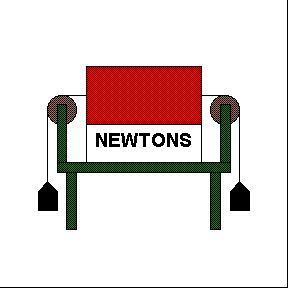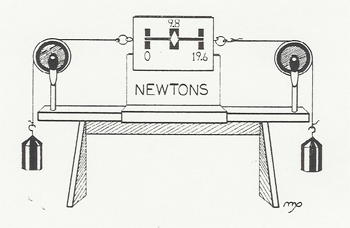- 1. Mechanics
- A. First Day Demos
- B. First Law, Inertia
- C. Second Law
- D. Third Law
- E. Angular Momentum
- F. Ballistics
- G. Center of Mass Demonstrations
- H. Energy
- I. Friction
- J. Gravitational Acceleration
- K. Kinematics
- L. Momentum and Collisions
- M. Nonlinear Mechanics
- N. Rotational Inertia
- O. Statics
- P. Torque
- Q. Uniform Circular Motion
- R. Vectors and Forces
- S. Data Studio
- 2. Harmonic Motion, Waves and Sound
- 3. Matter and Thermodynamics
- 4. Electricity and Magnetism
- 5. Light and Optics
- 6. Modern Physics
- 7. Astronomy
- 8. Software and Multimedia
- 9. Index and code conversion from older manual
- External Resources
20. Paradox of Forces
A 1 kg mass weighs 9.8 N as checked by a spring scale. Two 1 kg masses are hooked on the ends of a string which is passed over a pair of pulleys, and the spring scale is placed in the center of the string to measure the tension as shown. The scale is covered with a cloth to hide its reading, and the class is then asked to predict whether the scale will read 0, 9.8, or 19.6 N.


